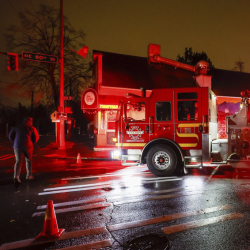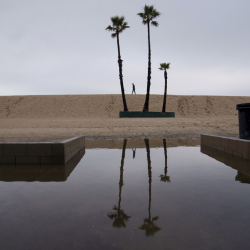(Editor's note: This is the complete statement issued by Mayor Sam Adams this morning after the new Interstate Bridge design proposal was submitted to the Columbia River Crossing Advisory Committee.)
For reasons that are both fiscal and political, I believe the ground has recently shifted under the proposal for a new I-5 Columbia River Crossing (CRC).
First, a little history. On July 9, 2008 in an Oregonian guest editorial, I wrote:
"A bridge, yes, but only the right bridge…I will strongly oppose a final Columbia River Crossing project proposal that fails to address Portland's goals. I would rather miss this round of federal funding and live with the challenges and vulnerabilities of the current bridge for the next 10 or 20 years than build a bad bridge that would punish Portland for perhaps another 100 years."
Today, I am even more committed to this statement.
I intend to continue working to shape this bridge, even though it is not a city-led project. In early spring of this year, policy and political differences among project sponsors risked sinking the entire project in cross-river disagreement. I have great respect for Vancouver, Washington Mayor Royce Pollard, although we do not always agree. We did find enough common ground to offer a compromise in a February 25, 2009 joint guest editorial titled "The way forward across the Columbia," proposing:
"… [a] new cross-river partnership [agreement] that actively manages daily mobility to get the most out of our investment…[like] no other jurisdiction in the nation has done… to blaze a new trail toward smart transportation management and protect our investment for generations to come."
Our February agreement assumed tolls on the project, and separated into two parts the controversial issue of how big to build the bridge versus how many lanes to actually open to traffic.
We proposed that the bridge be built to accommodate up to three add/drop lanes and three through-lanes. Those lanes would not be created equal. The lanes would be phased in and managed over time.
Decisions about when to open lanes – and how many – would be made based on the goals of improving freight movement and reducing vehicle miles traveled and pollution.
Our fact-based decision-making process noted that on-the-ground success for both our cities had much riding on details that were yet to be determined.
"Done right, the project promises safer and more reliable multimodal travel for people and goods while reducing negative impacts on our environment. Done wrong, today's gridlock will move south to downtown Portland. And 20 years from now the bridge will once again be filled with stop-and-go traffic."
Since this compromise last February, several things have changed.
The project budget must be cut. The project has a price tag that we now know far exceeds likely available funds. Our federal legislators have made it clear that we need to scale back the project to win their support.
Tolls are in question. A mayoral election in Vancouver has called into question whether tolls will be included to help underwrite the cost of building and maintaining a new bridge.
Local funding of light rail is unknown. Based on public support for a "no tolls" option in Vancouver, I have new concerns about whether Vancouver voters will approve a required sales tax increase for light rail line operating funds.
I will not get involved in the Vancouver mayoral election. And I accept the will of the voters in Vancouver and Clark County on light rail and the CRC.
But out of respect for our cross-river neighbors I want to ensure clear communication between us, so I must reiterate my stance: no tolls, no new bridge. No light rail, no Columbia River Crossing project.
I agreed to a compromise in February because of the promised benefits of the CRC project: improved freight movement, reduced congestion, and lower greenhouse gas emissions. Without tolls and light rail, I do not believe these benefits can be achieved.
Tolls and light rail offer our strongest tool to manage demand and regulate congestion. I believe an untolled bridge of any size – or a crossing without light rail – will invite more freeway trips, leading to even greater sprawl and congestion.
That congestion hurts freight movement and increases greenhouse gas emissions. And without tolls to moderate demand and light rail to get cars off the road, today's congestion at the bridge moves south to the heart of Portland.
Back in February, I agreed to move forward with a bridge structure to accommodate up to 12 lanes -- emphasis added -- contingent on performance. Today, faced with financial realities and the fact that the project might not win Vancouver's approval for tolls and light rail funding, I believe we need to define and apply those performance goals now, and use them to make smart cost-cutting decisions.
The fiscal context for the CRC project has changed dramatically. The political assumptions for the CRC project are no longer on solid ground. Thus, I am suspending my support for the compromise agreement I helped fashion in February.
And it must meet a clear-eyed cost/benefit analysis in light of today's financial realities – an analysis based on the performance goals on which we, as a region, must all agree.
For example the benefits of the proposed 11th and 12th lanes are marginal compared to other aspects of the project. The range of lanes we must look at likely is not the previous 8 to 12 lanes but 6 to 10 lanes.
We cannot wait until the new bridge is built to apply the performance goals we're developing. We need to use these performance goals to help us weigh the costs and benefits of the proposed budget cuts before us – and decide how big the bridge will be.
Regardless of what happens on this project, I will work to solve the problems that have driven Portland's participation in this project all
along: to improve better freight connections to I-5 and I-205, ensure safer access options for Hayden Island and extend light rail to it.
I remain committed to helping a new crossing get built but has to be the right kind of project.
The right bridge is one that will improve safety, moves freight better, reduces congestion, and protects our natural environment – all at a price tag we can truly afford. It includes light rail and it must be tolled to manage demand as well as pay for the project.






















































































































































































































































































































































